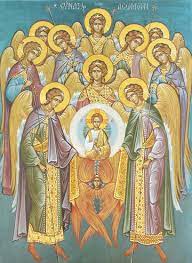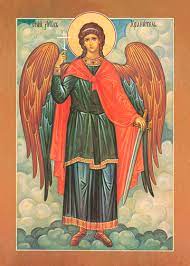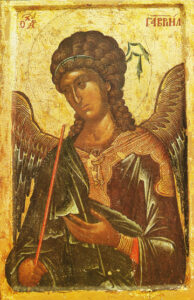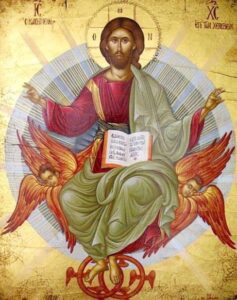
“Mommy, does Grandma have wings now?” “Yes, dear, when Grandma died she went to heaven and turned into an angel.” Wrong! Statistics say 80% of Americans believe in angels, but I wonder what they believe about them. My wife wisely cautions that when people are grieving is not the time to argue the point with them. But nevertheless it’s wrong. Angels are angels, and people are people. I’m embarrassed to say I even heard an Orthodox priest say in a funeral homily, “And now she’s our lovely angel in heaven.” Do any of you know where this mythology came from? And I can’t think anyone actually believes in those sweet naked baby cherubs on Christmas cards, but who knows? They seem to derive from Renaissance Roman Catholic imagery. As I mentioned a while back, in Spain my wife and I saw fat nasty ugly naked cherubs on the ceilings of churches. Where ever did they come from? As we go along, we’ll talk about the actual Cherubim – fearsome and overwhelming.
In these two articles, we are going to consider the following: 1) The term “Bodiless Powers of Heaven.” 2) What these Bodiless Powers are actually like – what little we know or can express of them. 3) What it’s like to experience the presence of an angel. 4) What difference can all this possibly make to us?
“Bodiless Powers of Heaven”
When I was Anglican I always loved our celebration of Saint Michael and All Angels on September 29. When I became Orthodox and discovered that we celebrate “The Archangels Michael and Gabriel and All the Bodiless Powers of Heaven” on November 8, I thought it a very odd title. (No one seems to have a good explanation for either date.) I was glad that the Orthodox Church allows Gabriel to get his immaterial foot in the door – but “Bodiless Powers”?
Now I see the point. According to the Scriptures there are many “ranks” of bodiless beings, of which angels and archangels are only two. Their titles are gathered from the Scriptures – Genesis, Isaiah, Ezekiel, Saint Paul. (The Church judges that Paul knew what he was talking about, since it is generally thought that he himself was the man he refers to in 2 Corinthians 12, who was lifted up into the third heaven – whatever that means, and Paul wasn’t saying.)
I have found it very helpful to think of these beings first as “Powers” – great forces moving through the cosmos, who are also persons, personal. They are “Bodiless” because they have no material bodies, in terms of our universe. To make themselves known to us they have to take an appearance, of which we’ll speak later. We must use imagery of them, but in all that follows, think of them first as “Powers”, not as creatures with wings. They are called Bodiless Powers “of Heaven” because they are sinless, un-fallen, and so even when they are moving on earth, they are still in Heaven, always fully, consciously in the presence of God. Can we imagine all this? No.
The Ranks of Bodiless Powers
Angels. Remember again that our knowledge of the higher world is very slight. Much of this “is a mystery”, as we Orthodox love to say. The term “angel” (Greek “angelos”, messenger) is used only for the lowest rank, such as the guardian angels who minister continually to us on earth. Angels are assigned to human beings. At Baptism we pray “Yoke to (his) (her) life a radiant angel, who shall deliver (him) (her) from every snare of the adversary”. We pray at Divine Liturgy for God to give us “an angel of peace, a faithful guide, a guardian of our souls and bodies”.
In the New Testament an angel guided Joseph in his dreams. At Christ’s birth an angel appeared to the shepherds, and then the skies were filled with angels singing “Glory to God in the highest and on earth peace good will toward men”. We sing an elaboration of that angelic hymn at the end of Matins (Orthros) just before Divine Liturgy begins. (You Orthodox (most of you, I mean), why don’t you sometime come to church on time and hear it?) After Jesus’ temptation “angels came and ministered to Him”, and again in the Garden of Gethsemane. According to Matthew, at His resurrection the women saw “an angel, his countenance like lightning, his clothing white as snow”. Later angels guarded the apostles and rescued them from jail. In the mysterious book of Revelation, John described the work of the angels in history destroying and building up world powers, and it is an angel who will announce The End: “Behold the Kingdoms of this world have become the Kingdom of our God and of his Christ”. As Jesus said, “At the last judgment the Son of Man will appear with all His holy angels. Then they will see the Son of Man coming in clouds with great power… and all the holy angels with Him”. And there’s much more.


Then come Archangels, chief angels. The distinction between angels and archangels is not always clear in the Scriptures. According to the mysterious vision in Daniel 10-12, angels or archangels are assigned to guard the nations on earth. Michael is the warrior, the “prince” assigned to the Jewish nation. Revelation 12 tells us that when “war arose in heaven”, Michael led the battle against Satan and his armies of rebellious angels. The Archangel Gabriel announced the conception of John the Baptist to Zacharias. He announced to the Virgin Mary that she would become the Mother of God, in words that would be used by hundreds of millions of Christians each day: “Hail full of grace. The Lord is with you. You shall have a Son and shall call Him Jesus… of His kingdom there will be no end.” We recite those last angelic words in the Creed. In most Orthodox churches icons of Michael and Gabriel are on or near the “deacon’s doors”, guarding the gates of heaven. In the book of Tobit the healing Archangel Raphael appears. Jewish tradition also lists Uriel, Selaphiel, Jegudiel and Barachiel, a total of 7, sometimes associated with the days of the week. Wouldn’t it be nice if we called days after Archangels instead of pagan deities? (Or then again, “Jegudielsday”?)
( I will resist putting in a commercial here for the wonderfully named Seven Angels Restaurant, just up the road from us in Chilton, Wisconsin.)
The Archangels all have masculine names, to symbolize strength. (Women aren’t strong? Don’t tell that to my wife!) But since they have no bodies, of course they are of neither sex, and you’ll note that they never have beards and their faces are neither masculine nor feminine.
Now let’s take the other ranks working down from the top::

Seraphim are thought to be the highest rank of Bodiless Powers, forever in the heights of heaven praising God around this throne. In Orthodox iconography they, with their six wings, surround the icon of Christ the Pantocrator in the dome of the church. Isaiah 6: 1-5. “In the year that King Uzziah died, I saw the Lord sitting on a throne, high and lifted up, and the train of His robe filled the temple. Above it stood seraphim; each one had six wings: with two he covered his face, with two he covered his feet, and with two he flew. And one cried to another and said: Holy, holy, holy is the Lord of hosts; The whole earth is full of His glory! And the posts of the door were shaken by the voice of him who cried out, and the house was filled with smoke. So I said: Woe is me, for I am undone! Because I am a man of unclean lips, and I dwell in the midst of a people of unclean lips; for my eyes have seen the King, the Lord of hosts.” In the Divine Liturgy, as we approach the throne of God, we join in the hymn of the seraphim, “Holy, holy holy, Lord God of hosts. Heaven and earth are full of Your glory.” We sing another version of it earlier after the Little Entrance: “Holy God, Holy Mighty, Holy Immortal”. And at the Great Entrance: “Let us who mystically represent the cherubim and sing the Thrice-holy Hymn to the life-creating Trinity, now lay aside all earthly cares…” And as you well know, yet another form of the Thrice Holy Hymn is part of our daily prayers which all Orthodox know by heart: “Holy God, Holy Mighty, Holy Immortal, have mercy on us.”

Which brings us to the Cherubim. Cute little babies with wings? I think not. In Genesis 3 “God placed cherubim at the east of the garden of Eden, with a flaming sword which turned every way, to guard the way to the tree of life”, so that fallen mankind could never return again.
Or this from Ezekiel’s vision of cloud and lightning which came out of the north, and four living creatures: “Each one had four faces: the first face was the face of a cherub, the second face the face of a man, the third the face of a lion, and the fourth the face of an eagle. And the cherubim were lifted up. This was the living creature I saw by the River Chebar. When the cherubim went, the wheels went beside them; and when the cherubim lifted their wings to mount up from the earth, the same wheels also did not turn from beside them. When the cherubim stood still, the wheels stood still, and when one was lifted up, the other lifted itself up, for the spirit of the living creature was in them. Then the glory of the Lord departed from the threshold of the temple and stood over the cherubim. And the cherubim lifted their wings and mounted up from the earth in my sight. When they went out, the wheels beside them, they stood at the door of the east gate of the Lord’s house, and the glory of the God of Israel was above them. This is the living creature I saw under the God of Israel by the River Chebar, and I knew they were cherubim. Each one had four faces and each one four wings, and the likeness of the hands of a man was under their wings.” Let’s try putting those on our Christmas cards!
Who can comprehend all this? Other than our Lord, only one human being. We sing to the Virgin Theotokos: “More honorable than the cherubim and more glorious beyond compare than the seraphim, we magnify you”. What Christ is by nature, she has become by grace. And that is our future, too, if we will have it. We also are to be made over into the likeness of Christ. Saint Paul wrote (I Corinthians 6:3), “Do you not know that you will judge angels?” Prepare now for your voyage into the utterly unknown, the world of cherubim and seraphim.
The “middle ranks” include Principalities, Powers, Virtues, Dominions and Thrones (and there may be more) about whom we know almost nothing except their names. All we know is what little has been revealed to us.
Principalities and powers may be the fallen angels. For not all angels are good. Lucifer was an archangel who rebelled against God. His followers are called fallen angels, evil spirits, demons – angels of destruction. The book of Revelation says that when Michael fought against the devil and his angels, they lost and were confined to earth. (Is the rest of the cosmos still un-fallen?) We do not see them, but we see the results of their work all around us.
Tune in next week for the rest of the story.
Next Week: Part 2- What is it like to be in the presence of an angel? What difference can all this unworldly stuff make to us?
Week after Next: Back to our series on Other Faiths: Judaism.
December will be devoted to “The War on Advent” and “Saint Nicholas”.
Pre-Vatican 2, the Roman calendar had separate feast days each for Gabriel, Raphael, & Guardian Angels, and two for Michael (Sept & May.) The May one is on the Byzantine calendar too I think. After Vat 2, they only kept 2 days: Sept 29 for Michael et al, and one for the guardian angels.
There’s a good book by Mother +Alexandra, The Holy Angels. (She founded Holy Transfiguration monastery in PA.) The book looks at angels in scripture, the fathers, and the Liturgies east and west.
Why have the Roman Catholics eliminated so many saints’ days and the octaves of feast days? This so diminishes the richness of Christianity. Thank you for reminding me of Mother Alexandra’s excellent book. I’ll recommend it in Part Two.
http://www.theoi.com/Olympios/AphroditeAttendants.html#Erotes
Cherubs as little children with wings.
I studied a bit of Classical Art such as mosaics like this many years ago and this must be what I vaguely remembered.! I suppose the Italians of the Renaissance preferred the Classical models for imitation to show how educated they were. Medieval pictures would be different.
Excellent article with a bit of humor. Thank you!